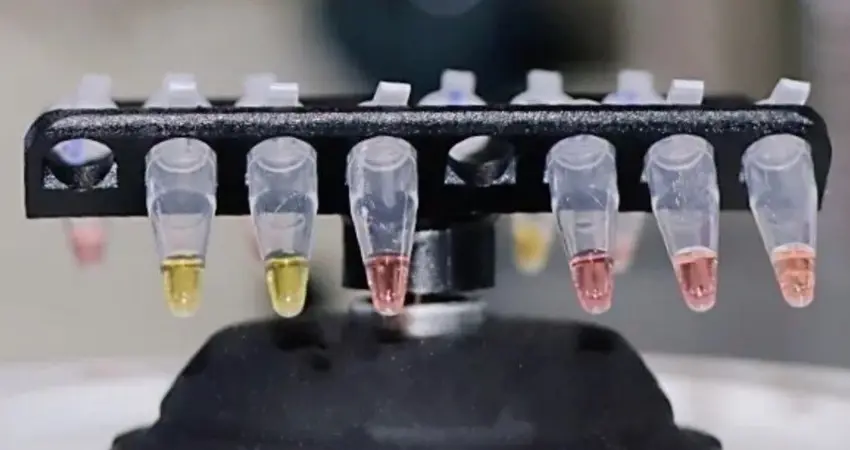07 Jul 2020
Oxford scientists form spinout to launch rapid Covid-19 virus test
Covid-19 pandemic demands availability of highly accessible and rapid testing around the world to enable countries to emerge from lockdown with confidence

The test uses a simple colour change to identity presence of the virus. A positive sample changes from pink to yellow
The Covid-19 pandemic demands availability of highly accessible and rapid testing around the world to detect SARS-CoV-2 and enable countries to emerge from lockdown with confidence.
Scientists from the Department of Engineering Science and Oxford Suzhou Centre for Advanced Research (OSCAR) have developed a rapid test which detects the presence of the virus - confirming if a person is currently infected and likely to be infectious - which could be adapted for use in settings ranging from community care, schools, airports or home self-testing.
Oxford University Innovation (OUI), the research commercialisation company of the University, has supported the formation of a lean spin-out company named Oxsed Ltd, a social venture to commercialise and distribute technology jointly developed at Oxford University and OSCAR for detection of Covid-19.
The test will soon be certified with the CE-mark and be shortly available in quantity with the commercial product name 'Oxsed RaViD Direct'. The test will cost no more than £20 per test, which is considerably cheaper than most of the products currently on market.
The Oxford-OSCAR team has designed primers with high specificity to confirm presence of the virus in infected people, adapted from an established technology known as RT-LAMP (reverse transcription-loop mediated isothermal amplification). It is a simplified one-step version of a viral RNA test and can be used in the field without specialist equipment or training. The simple colorimetric result is read by eye or fluorescent display, meaning there is no need for additional tools to analyse results. A bluetooth linked fluorescent detection instrument can link the test result into a laboratory information system, so that test results can be tracked.
Across the world, countries face the combined challenges of controlling the spread of SARS-CoV-2 while maintaining an economically productive workforce. Current testing relies on complex lab tests with supply chain issues arising from unprecedented demand; challenges of sample collection and turnaround time for results. Developing countries also suffer from a lack of testing labs and the financing of mass testing. Yet effective testing strategies are key for releasing countries from lockdown in a safe and sustainable way.
This test produces results within 30-45 min. It detects SARS-CoV-19 with great sensitivity and specificity using throat/nasal swabs directly to identify individuals carrying the virus. Clinical trials gave comparable results with laboratory tests, demonstrating reliability - the results will be published shortly.
Professor Zhanfeng Cui, the Director of OSCAR, said: ‘Our test is ideal for use in community or field settings by lay persons and allows immediate decisions to be made. Immediate applications are: returning to work/education (i.e. schools, universities, companies) and making quarantine decision (e.g. care homes, hospitals, temporary migrants, tourists). Use of such a test could be crucial to economic recovery globally.’
Dr Jane Jin, a Senior Licensing and Venture Manager at Oxford University Innovation, adds: ‘Speed of response is crucial in the current pandemic, and we are very pleased to have supported our researchers through the commercialisation process in just three months. Now that the social venture has been incorporated we look forward to seeing the technology deployed globally at scale, in particular in resource-poor developing countries.’
Professor Wei Huang, who designed the primers to target the viral RNA, explains the advantage of the Oxford test, ‘By designing the specific primers and controlling the biochemical reaction, we are able to eliminate the non-specific reactions that cause false positives and make our RT-LAMP test robust. And the Oxford test can be transported and stored at ambient temperature without need for cold chain, which makes shipping and distribution much easier”.
Dr Monique Andersson, Consultant Virologist and Director of Microbiology, Oxford University Hospitals NHS Foundation Trust, who leads the clinical validation of the test said: “An advantage of using LAMP technology is that it uses different reagents to most laboratory based PCR tests. Implementation of this test for screening would ease the pressure on the PCR reagent supply chain in the NHS. In terms of its wider application, the assay requires little infrastructure and is relatively low cost, making it a viable option for widespread testing in LMIC’.
The project was initiated by Oxford Suzhou Centre for Advanced Research (OSCAR), a University of Oxford centre in Suzhou Industrial Park. The experiments to develop the technology were performed in the Department of Engineering Science at the University of Oxford. Clinical validation on direct use of swab solution was performed in Oxford University Hospitals NHS Foundation Trust, Peter Medawar Institute of Virology, Sir William Dunn School of Pathology, University of Oxford.
Latest updates on COVID-19 research at Oxford: http://www.ox.ac.uk/coronavirus-research




